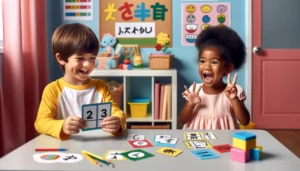Japanese adjectives are key to expressing detailed and nuanced thoughts in Japanese. Learning them enriches your sentences, allowing for more vibrant storytelling and deeper connections in conversations. Their varied forms and conjugations add complexity but are crucial for achieving fluency in the language.

✅ AI Essay Writer ✅ AI Detector ✅ Plagchecker ✅ Paraphraser
✅ Summarizer ✅ Citation Generator
In Japanese, adjectives are not just mere words; they’re the paintbrushes that color your conversations. Whether describing objects, people, or experiences, adjectives add depth and emotion to your speech. Japanese has two main types of adjectives: い (i) adjectives and な (na) adjectives, each with unique conjugations. This article will delve into how these adjectives work, their placement in sentences, conjugation rules, and a list of common adjectives with examples. By understanding these adjectives, learners can better articulate their thoughts and engage more effectively with native speakers, enhancing their overall communication skills in Japanese.
Understanding い and な Adjectives
Japanese adjectives are categorized into two types: い (i) adjectives and な (na) adjectives. Both types are integral to forming descriptive and meaningful sentences in Japanese.
い (i) Adjectives
い adjectives, also known as “true adjectives,” always end with the character い. They can function independently or modify a noun. Here are some examples:
| Japanese | English | Pronunciation |
| 寒い | Cold | Samui |
| 速い | Fast | Hayai |
| 甘い | Sweet | Amai |
| 新しい | New | Atarashii |
| 面白い | Interesting | Omoshiroi |
Examples:
- 今日は寒いです。(Kyō wa samui desu.) – It is cold today.
- 彼は速いランナーです。(Kare wa hayai rannā desu.) – He is a fast runner.
- このケーキは甘いです。(Kono kēki wa amai desu.) – This cake is sweet.
- 新しい車が欲しい。(Atarashii kuruma ga hoshii.) – I want a new car.
- その映画は面白かった。(Sono eiga wa omoshirokatta.) – That movie was interesting.
な (na) Adjectives
な adjectives, or “quasi-adjectives,” can end in various characters, including い. They require the particle な when modifying a noun. Here are some examples:
| Japanese | English | Pronunciation |
| 元気 | Healthy/Lively | Genki |
| きれい | Pretty/Clean | Kirei |
| 好き | Favorite | Suki |
| 静か | Quiet | Shizuka |
| 有名 | Famous | Yūmei |
Examples:
- 彼女は元気な女の子です。(Kanojo wa genki na onnanoko desu.) – She is a lively girl.
- この部屋はとてもきれいです。(Kono heya wa totemo kirei desu.) – This room is very clean.
- 犬が好きです。(Inu ga suki desu.) – I like dogs.
- 図書館は静かです。(Toshokan wa shizuka desu.) – The library is quiet.
- 彼は有名な俳優です。(Kare wa yūmei na haiyū desu.) – He is a famous actor.
Conjugation of Japanese Adjectives
Japanese adjectives are broadly classified into two types: い (i) adjectives and な (na) adjectives. Understanding their conjugation is crucial for effective communication in Japanese. Below are tables summarizing their forms, translations, pronunciations, and example sentences.
い Adjectives (True Adjectives)
These adjectives always end in い (i). However, not all adjectives ending in い are true adjectives. They can describe a noun directly or stand alone.
| Japanese | English Translation | Pronunciation | Example Sentence |
| 寒い | Cold | Samui | 今日は寒いです。(It is cold today.) |
| 速い | Fast | Hayai | 彼は速い走ります。(He runs fast.) |
| 甘い | Sweet | Amai | このケーキは甘い。(This cake is sweet.) |
| 新しい | New | Atarashii | 新しい車を買いました。(I bought a new car.) |
| 面白い | Interesting | Omoshiroi | この本は面白い。(This book is interesting.) |
Conjugation of い Adjective (Example: 速い – Fast)
| Tense | Plain | Polite | Example Sentence |
| Present (is fast) | 速い (Hayai) | 速いです (Hayai desu) | 車は速い。(The car is fast.) |
| Present Negative (isn’t fast) | 速くない (Hayakunai) | 速くありません (Hayaku arimasen) | 車は速くない。(The car isn’t fast.) |
| Past (was fast) | 速かった (Hayakatta) | 速かったです (Hayakatta desu) | 車は速かった。(The car was fast.) |
| Past Negative (wasn’t fast) | 速くなかった (Hayakunakatta) | 速くありませんでした (Hayaku arimasen deshita) | 車は速くなかった。(The car wasn’t fast.) |
The Only Irregular Japanese Adjective
| Japanese | English Translation | Pronunciation | Example Sentence |
| 良い | Good | Ii/Yoi | このレストランは良い。(This restaurant is good.) |
Conjugation of 良い (Good)
| Tense | Plain | Polite | Example Sentence |
| Present (is good) | 良い (Ii) | 良いです (Ii desu) | 彼は良い先生です。(He is a good teacher.) |
| Present Negative (isn’t good) | 良くない (Yokunai) | 良くありません (Yoku arimasen) | 彼は良くない先生です。(He isn’t a good teacher.) |
| Past (was good) | 良かった (Yokatta) | 良かったです (Yokatta desu) | 彼は良かった先生です。(He was a good teacher.) |
| Past Negative (wasn’t good) | 良くなかった (Yokunakatta) | 良くありませんでした (Yoku arimasen deshita) | 彼は良くなかった先生です。(He wasn’t a good teacher.) |
な Adjectives (Quasi-Adjectives)
These adjectives often end in various characters, sometimes even in い. They are used with な when preceding a noun.
| Japanese | English Translation | Pronunciation | Example Sentence |
| 元気 | Healthy/Lively | Genki | 彼女はいつも元気です。(She is always lively.) |
| きれい | Pretty/Clean | Kirei | その花はきれいです。(That flower is pretty.) |
| 好き | Favorite | Suki | 猫が好きです。(I like cats.) |
| 静か | Quiet | Shizuka | ここは静かな場所です。(This is a quiet place.) |
| 有名 | Famous | Yumei | 彼は有名な歌手です。(He is a famous singer.) |
Conjugation of な Adjective (Example: 元気 – Healthy/Lively)
| Tense | Plain | Polite | Example Sentence |
| Present (is lively) | 元気だ (Genki da) | 元気です (Genki desu) | 彼は元気だ。(He is lively.) |
| Present Negative (isn’t lively) | 元気ではない (Genki de wa nai) | 元気ではありません (Genki de wa arimasen) | 彼は元気ではない。(He isn’t lively.) |
| Past (was lively) | 元気だった (Genki datta) | 元気でした (Genki deshita) | 彼は元気だった。(He was lively.) |
| Past Negative (wasn’t lively) | 元気ではなかった (Genki de wa nakatta) | 元気ではありませんでした (Genki de wa arimasen deshita) | 彼は元気ではなかった。(He wasn’t lively.) |
Common Japanese Adjectives
To start learning, consider these commonly used adjectives and their conjugations.
| Japanese | English Translation | Pronunciation | Example Sentence |
| 大きい | Big | Ookii | その建物は大きい。(That building is big.) |
| せまい | Small | Semai | 部屋がせまい。(The room is small.) |
| 悪い | Bad | Warui | その考えは悪い。(That idea is bad.) |
| 美しい | Beautiful | Utsukushii | 彼女は美しい。(She is beautiful.) |
| 高い | Expensive | Takai | この服は高い。(This dress is expensive.) |
Understanding these conjugations and regularly practicing them in sentences will greatly improve your proficiency in Japanese.
FAQ
Follow us on Reddit for more insights and updates.





Comments (0)
Welcome to A*Help comments!
We’re all about debate and discussion at A*Help.
We value the diverse opinions of users, so you may find points of view that you don’t agree with. And that’s cool. However, there are certain things we’re not OK with: attempts to manipulate our data in any way, for example, or the posting of discriminative, offensive, hateful, or disparaging material.